
Search
The Renewable Energy site for Do-It-Yourselfers
Tom's Wind Turbine
-- Building the Tower
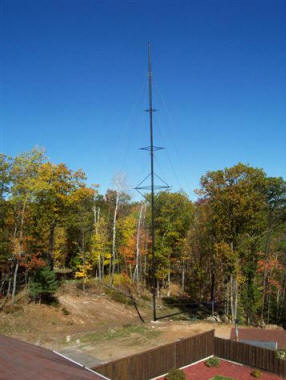
Since I could find no current "tilt
style" wind generator towers over 80' to copy, I elected to expand on the design
Prairie Turbines uses for the smaller towers and add common sense modifications
to it. The tower is fabricated out of 3 - 42' lengths of 12" x 3/16" wall pipe
with a 12' length of 8 1/2" x 3/16" wall pipe for the final extension. The
center truss is located just over 60' up the tower, which is fabricated out of 2
1/2" thin wall pipe. This truss is supported by 45 degree angle supports to the
tower as well, as the 5/8" truss cables place a tremendous amount of strain on
the center truss when tightened by the turnbuckles on the bottom to straighten
the tower.
The four other tower trusses are made from the same material and sized
appropriately to scale so the cable runs straight over the center to the top and
bottom attach points. If I was to build another tower, I would size the four
smaller trusses larger so the cable placed a little more inward pressure on the
tower (even when perfectly straight). All trusses have pipes welded on the end
of them (guide tubes) to secure and route the cable as it runs past each truss.
The center truss "guide tubes" were cut from a piece of 90 degree x 2 1/2" hard
galvanized conduit normally used for the entrance conduit for an electrical
service. I cut 4 pieces at about 22.5 degrees so I could compensate for the
angle at the center truss and not damage the cables when they transitioned this
bend. An added benefit of these guides is they closed off the end of the truss
tubes. We cut and sized everything at my shop (I own a truck dealership and
fabrication shop), and hauled it to my home at the time we were ready to
assemble the tower.
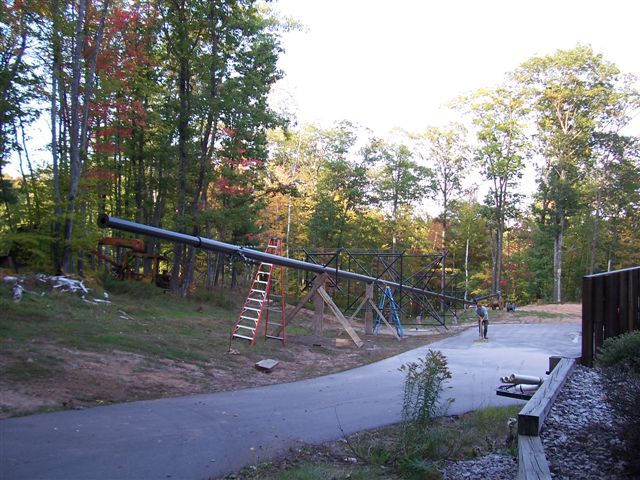
Tower with truss work added. Note the temporary supports for the tower.
Tom is recovering the sand used sandblast the pipe before painting.
When the cement work was done, it was time to transport and assemble the tower.
We hauled the pipe out with a large truck and trailer, unloading it with my
front end loader (although a small tractor with a front bucket would have served
fine too). Once we had two of the 42' lengths of pipe welded together, it was
evident this would need supports every 25' or so. The supports were not an issue
at first, but once we started installing the truss piping, we realized the end
of the pipe (at 140') would need to be quite a ways off the ground to clear the
center truss. We made tower supports out of 2x10's, with a vertical support, two
side supports at a 45 degree angle going from the tower to the ground, and a
bottom support that tied all the boards together. These were leveled as well (my
ground was slightly pitched where the tower lies in the down position). We were
able to straighten the tower with the ground supports. It was surprising how
much the pipe would bend over it's length before the truss and cable portion was
finished and tensioned up. At this stage I was truly getting nervous. It seemed
like the scope of the project may have gotten larger than my engineering
abilities. The tower looked HUGE.
We welded the gin pole sections together and supported it for the truss work.
This would have a tremendous amount of stress on it during the initial part of
the tower raising. 20,000 lbs of force trying to compress this would likely
collapse the pole without some "truss like" support. Using the same scale
Prairie Turbines used for their "standard" 60' tower, I installed a truss on the
gin pole made mostly with 3/4" re-rod, and 1 1/4" Schedule 80 pipe on the center
truss. Re-rod was used for the tension part of the truss system as well, with
the pole hung various ways to "tension" the re-rod while welding to the pole.
|
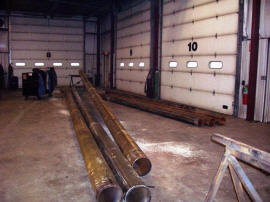
Steel pipe used to fabricate the main tower pole. |
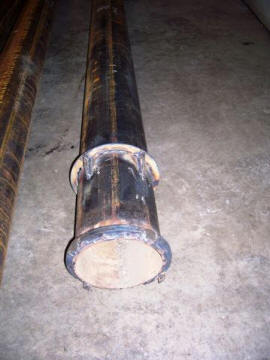 |
I was able to "borrow" a large capacity compressor and portable sand blaster to
blast and paint the project. The sand blaster held about 300 lbs. of sand and
the compressor had a 6 cylinder flat head gasoline engine powering it. I
recycled most of the sand by laying two large tarps down, but still purchased
1500 lbs to complete the project. Since the project was so big, we had to break
the blasting and painting into 4 segments. Any freshly blasted metal could not
be left overnight or it would rust, so painting had to be competed the same day
as the blasting. The gin pole was finished on one day (about 8 hours). The main
pole was broken into 3 days (or partial days) of blasting and painting. We used
a special Sherwin Williams industrial epoxy paint that did not require primer
and rolled it on with small rollers. This was one stage my wife Beth really
helped a lot; timing was critical to get the fast drying paint on before it set
(and it got dark outside). As you can see from the pictures, my 8' and 12' step
ladder got a workout for a lot of the painting.
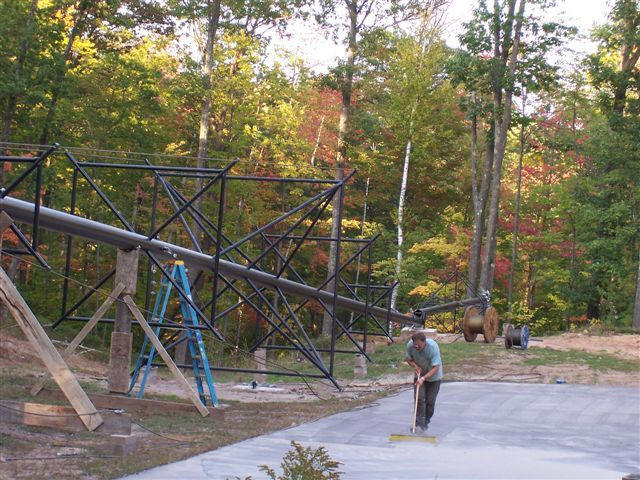
Closer view of the tower truss work.
Tom
October 20, 2008





